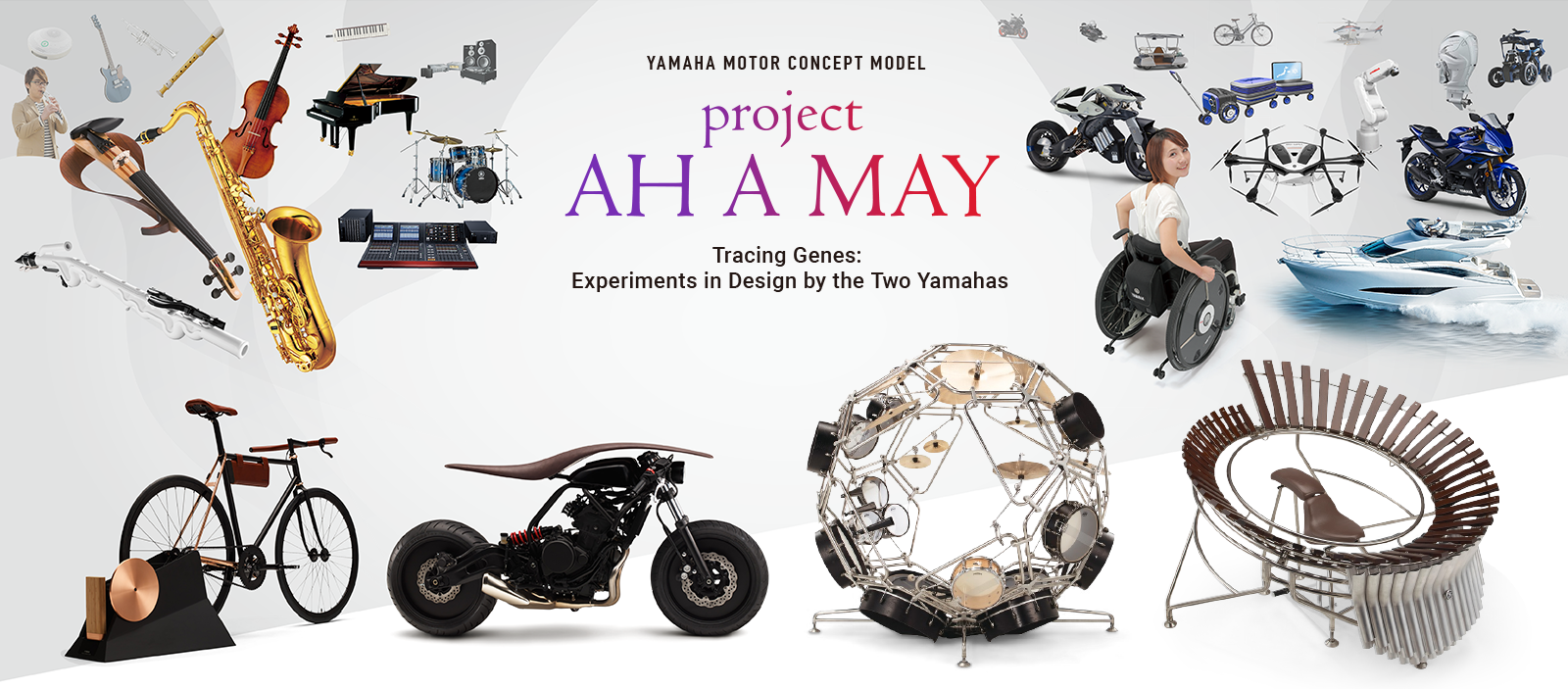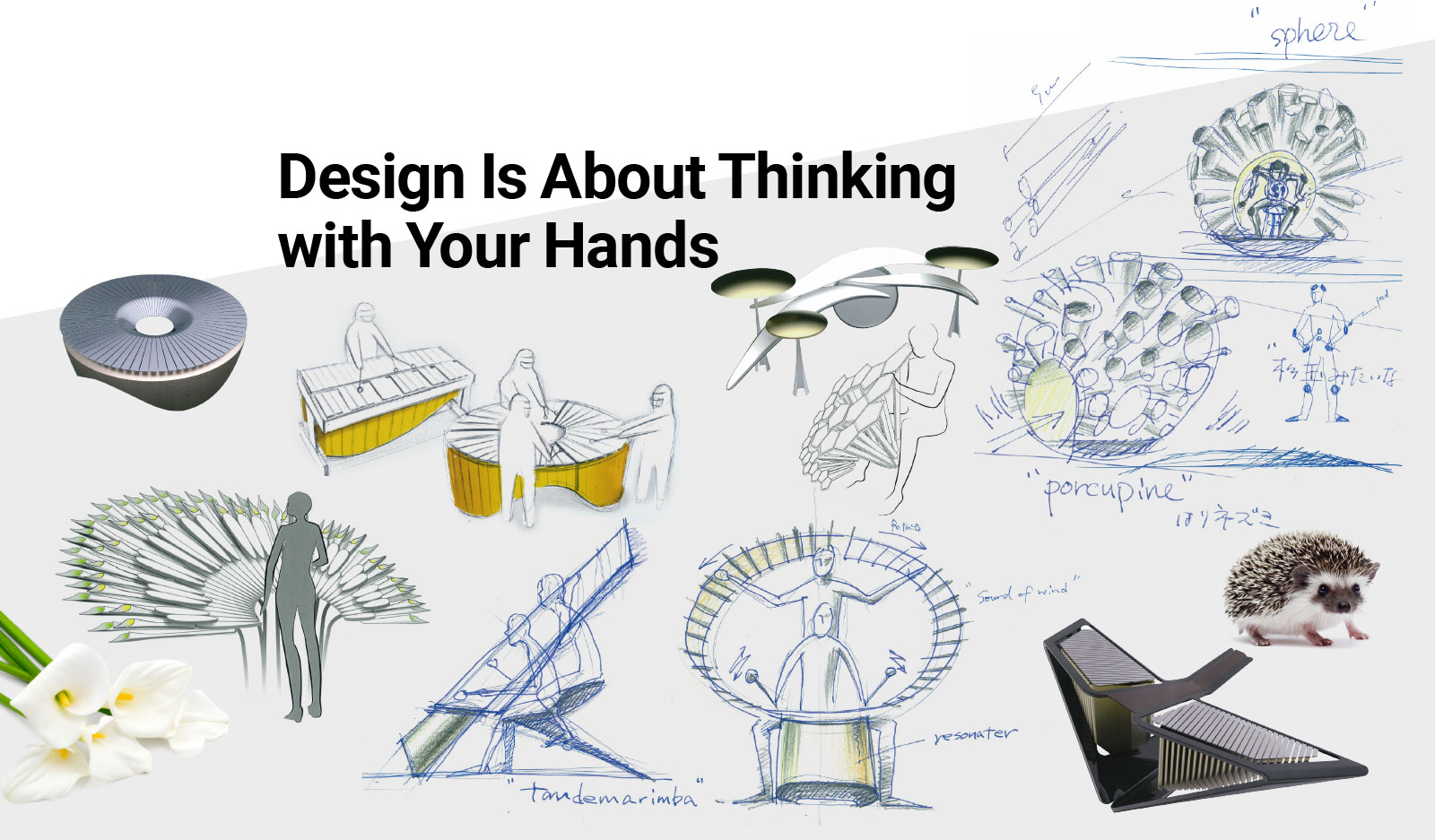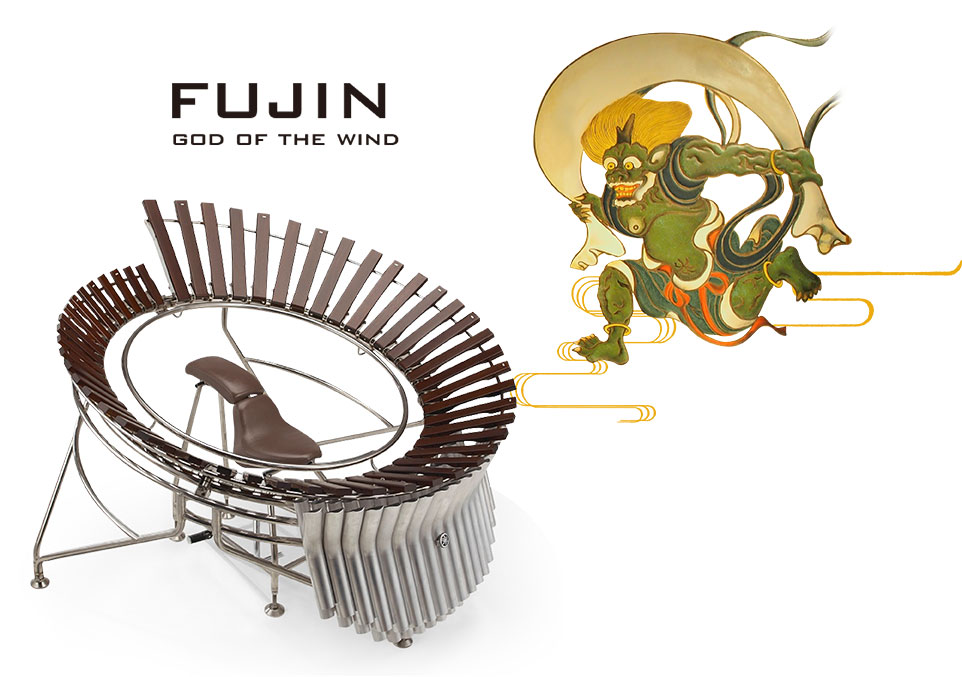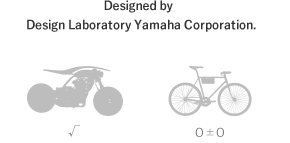Mobility product manufacturer Yamaha Motor Co., Ltd. and musical instrument and audio system manufacturer Yamaha Corporation are two different companies, but they have the same roots, the same Yamaha brand name, and the same tuning fork motif in their respective logos. This is why many people around the world think they are one and the same, despite their products being vastly different. It’s also the reason why what comes to mind when people hear or see the Yamaha brand name often varies based on individual interests or the country they live in.
“Two Yamahas, One Passion” is an initiative launched by the two companies in 2015 to work together to raise the brand value associated with the Yamaha name. For some time, there had been a history of exchange between the two companies’ designers through joint-projects—like a graphic design contest—that led to deeper mutual understanding, and this history led them to an intriguing question: “While different, we are both Yamaha, so in what ways do our identities, values and design styles overlap?”


The search for an answer to this question kickstarted a collaborative effort by the two companies’ design divisions: “project AH A MAY.” This experiment would give the companies’ designers full freedom to create new designs for each other’s products—Yamaha Motor designers would come up with designs for musical instruments and Yamaha Corporation designers would create designs for mobility products. This approach is reflected in the “AH A MAY” in the project name, a reverse reading of “YAMAHA.” The project would figuratively have the designers look at themselves in front of a mirror symbolizing the other company and try to better understand each other’s style.
What kind of design could emerge from a mobility product designer starting from scratch to design a musical instrument? With no correct answer to this question and no way to imagine what the finished product would look like, this somewhat peculiar design experiment began.

From among the products offered by “the musical Yamaha,” “the mobility Yamaha” chose to use marimbas and drums. What’s more, it was decided that for this project, the designers of both companies would deliberately and entirely ignore the conventions and common practices of their counterparts, and if there was something they wished to know more about, they would research it themselves. The designers would also conduct no cross-scrutinizing or mid-way checks of the other company’s design work and stay faithful to the approach all the way through to building the prototypes, which turned out to be quite a thrilling undertaking.
The team at Yamaha Motor began by procuring the musical instruments they selected from Yamaha Corp. and examining the materials and construction by hand. With the marimba, this included checking the materials, thickness and width of the tone plates, and the relationship between the resonator pipes and the sounds produced. For the drum set, the construction of the various drums and cymbals like the snare drum and bass drum were checked as well as the pitch of the sound each made. In these ways, Yamaha Motor’s designers looked to first gain a basic understanding of the mechanisms of the instruments on their own, exploring the key elements involved in playing them and the sounds produced while formulating design ideas.
The marimba and drums are both percussion instruments that produce sounds when struck, making their structure quite simple. But to recreate them as all-new instruments, the designers kept asking themselves two questions: “Since we’re not bound by the standard forms and structures for existing instruments, how can we express the exhilaration and excitement that’s true to our style as ‘the mobility Yamaha?’” and “What kind of value can we offer that would be uniquely linked to our identity as Yamaha and as a motorcycle manufacturer?“
The designers held discussion and brainstorming sessions over and over while sketching the resulting outpouring of ideas one after another. Shown here are just a few examples of the many that emerged. Ideas sprang forth for a broad range of shapes and forms, with some imagined based on the related sounds and performance styles. The diversity of ideas spanned out in just about every direction and they were swiftly brought to life as sketches. It was through this repeated brainstorming process that the designers moved themselves farther and farther away from the somewhat “binding” conventions of musical instruments.
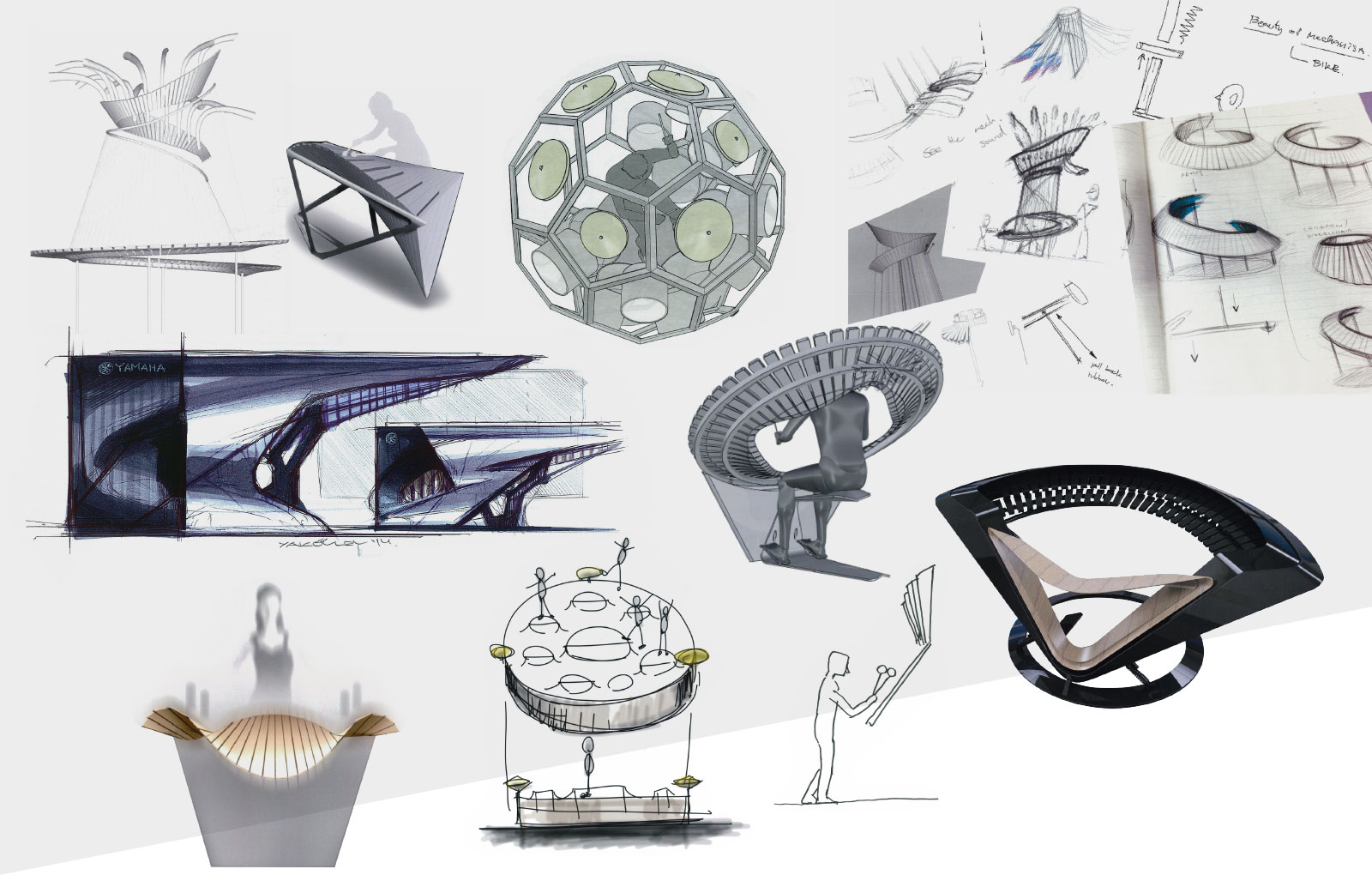
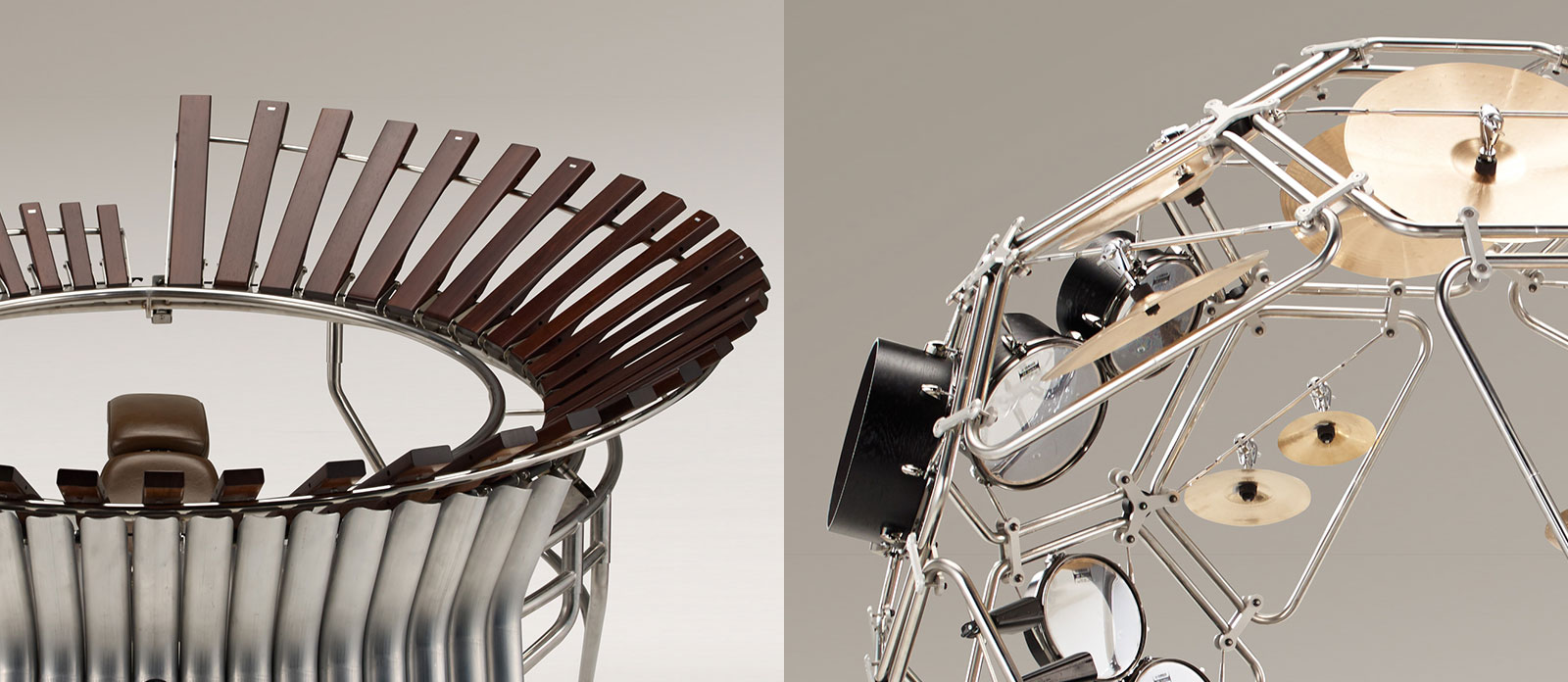
This adventurous design project that had the mobility Yamaha reinterpret the marimba and drum set brought forth two all-new instruments: the FUJIN (God of Wind) and RAIJIN (God of Thunder). The arrangement of the tone plates and drums is far removed from an ordinary marimba or drum set, but much like a motorcycle, both instruments are designed to position the player in the middle to produce a sense of unity, a clear indicator of the style and values held by Yamaha Motor designers. Also, the designs were created based on solid reasoning to realize their respective concepts rather than simply decorative taste, from the way the materials were used and shown to the approaches for ensuring functionality. The FUJIN and RAIJIN proved to be a reaffirmation for us of the DNA making Yamaha Design—in both music and mobility—unique.
The inventive design of this marimba has the tone plates encircle the two players that sit in the middle to perform, lined up like a rider and tandem passenger on a motorcycle. The highlight of the instrument is that the tone plates can be rotated around the players. The performer sitting in the rear rotates the tone plates for the player in front to play on—much like a two-up motorcycle ride. This adds a fun element of chance resulting from the differences in performer intent and timing, and with double the usual number of hands at work, the FUJIN can also be used to perform difficult pieces with large octave ranges. The instrument’s name comes from the visual spectacle of the tone plates rotating around the players like the bag of wind swung around by the Japanese God of Wind. The sight of the rotating tone plates also brings to mind the image of a motorcyclist boldly rounding a street corner.

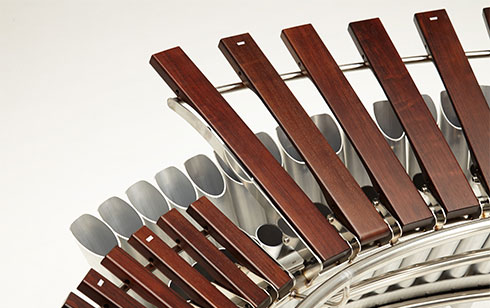
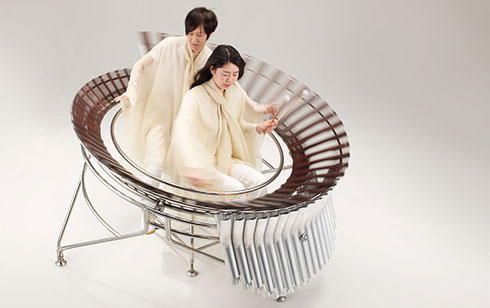
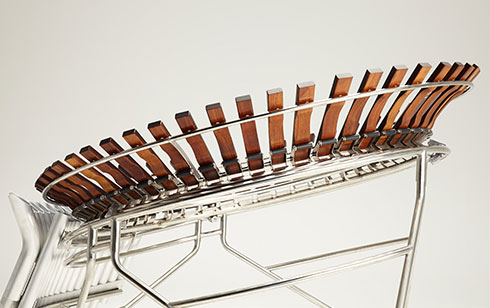
This unusually shaped drum set attaches the drums and cymbals to a frame similar in appearance to a sphere-shaped jungle gym. Conceived to pair with the FUJIN, it is named for the Japanese God of Thunder that throws lightning bolts and pounds his taiko drums to create thunder. The player performs from inside the sphere-like frame, allowing him or her to strike the drums and cymbals to their heart’s content or even spin around to play in what can look like a wild frenzy. The dynamic nature of the performance can indeed look like the rampaging thunder god, but it can also suggest the vibrant and powerful feel of an off-road motorcyclist using their body to muscle their machine around a dirt track.

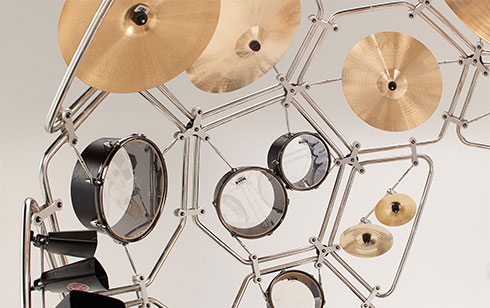

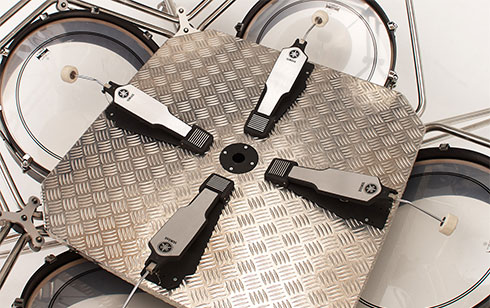
The Yamaha Motor designers that worked on this project state that they first conceived ideas for instruments that would amplify the energy of the performers and have structures that kindle a greater sense of unity with the audience, and then worked to actually design them. The FUJIN and RAIJIN both turned out to be instruments that entailed greater physical involvement to perform, much like how a motorcycle requires the rider to move and steer as one with it. In this sense, both embody the unique style of “the mobility Yamaha.” That is precisely why when the audience sees the energy released by the players amplified as they perform, they are struck by not just the sound but also a visual spectacle that heightens their connection to the music.
When the designers from the two Yamahas finally saw their counterparts’ designs for the first time, they were surprised by the similarities in their look and feel. Both mobility and music can get people “moving”; music moves people hearts and emotions while mobility products help people move by riding from place to place, both creating dimensions of fun and joy. And it is this pursuit that becomes the driving force behind both Yamahas of “sharing new Kando and rich cultural experiences with more people.”
In their shared desire to bring Kando to every person that uses a Yamaha product, project AH A MAY helped the designers reaffirm their belief that the unique style of Yamaha lies in the strong sense of mission and passion they bring to their respective Monozukuri for music and mobility.

